क्रमगुणित
| यह लेख एक आधार है। जानकारी जोड़कर इसे बढ़ाने में विकिपीडिया की मदद करें। |
| n | n! |
|---|---|
| 0 | 1 |
| 1 | 1 |
| 2 | 2 |
| 3 | 6 |
| 4 | 24 |
| 5 | 120 |
| 6 | 720 |
| 7 | 5040 |
| 8 | 40320 |
| 9 | 362880 |
| 10 | 3628800 |
| 11 | 39916800 |
| 12 | 479001600 |
| 13 | 6227020800 |
| 14 | 87178291200 |
| 15 | 1307674368000 |
| 16 | 20922789888000 |
| 17 | 355687428096000 |
| 18 | 6402373705728000 |
| 19 | 121645100408832000 |
| 20 | 2432902008176640000 |
| 70 | 1.197857167×१०100 |
| 100 | 9.332621544×१०157 |
| 450 | 1.733368733×१०1,000 |
| 1000 | 4.023872601×१०2,567 |
| 3249 | 6.412337687×१०10,000 |
| 10000 | 2.846259681×१०35,659 |
| 25206 | 1.205703438×१०1,00,000 |
| 100000 | 2.824229408×१०4,56,573 |
| 205023 | 2.503898931×१०10,00,004 |
| 1000000 | 8.263931687×१०55,65,708 |
| 1723508 | 5.290070307×१०1,00,00,001 |
| 2000000 | 3.776821058×१०1,17,33,474 |
| 10000000 | 1.2024234×१०6,56,57,059 |
| 14842907 | 2.788662974×१०10,00,00,000 |
गणित में किसी अऋणात्मक पूर्णांक n का क्रमगुणित या 'फैक्टोरियल' वह संख्या है जो उस पूर्णांक n तथा उससे छोटे सभी धनात्मक पूर्णांकों के गुननफल के बराबर होता है। इसे n!, से निरूपित किया जाता है। उदाहरण के लिये,
0! का मान is 1 होता है।
गणित के अनेकों क्षेत्रों में क्रमगुणित का उपयोग करना पड़ता है, जिनमें से क्रमचय-संचय, बीजगणित तथा गणितीय विश्लेषण प्रमुख हैं।
इतिहास[संपादित करें]
क्रमगुणित की अवधारणा कई संस्कृतियों में स्वतंत्र रूप से उत्पन्न हुई है:
- भारतीय गणित में, फैक्टोरियल का सबसे पहला ज्ञात विवरण अनुयोगद्वार-सूत्र से आता है,[1] जो जैन साहित्य के प्रामाणिक कार्यों में से एक है, जिसे 300 ईसा पूर्व से 400 ईसवी तक की तिथियां दी गई हैं।[2] यह वस्तुओं के एक समूह के क्रमबद्ध और उलटे क्रम को अन्य ("मिश्रित") क्रमों से अलग करता है, तथा क्रमगुणित के लिए सामान्य उत्पाद सूत्र से दो घटाकर मिश्रित ऑर्डर की संख्या का मूल्यांकन करता है। क्रमचय के लिए गुणन नियम का वर्णन 6वीं शताब्दी ई. के जैन भिक्षु जिनभद्र ने भी किया था।[1] हिंदू विद्वान कम से कम ११५० के बाद से क्रमगुणित सूत्रों का उपयोग कर रहे हैं, जब भास्कर द्वितीय ने अपने काम लीलावती में क्रमगुणित का उल्लेख किया था, एक समस्या के संबंध में कि विष्णु अपने चार विशिष्ट वस्तुओं (शंख, चक्र, गदा, और कमल का फूल) को अपने चार हाथों में कैसे पकड़ सकते हैं, और दस-हाथ वाले भगवान के लिए एक समान समस्या।[3]
- मध्य पूर्व के गणित में, सृष्टि की हिब्रू रहस्यवादी पुस्तक सेफर यतिजिराह, जो कि तल्मूडिक काल (200 से 500 ई.) की है, में 7! तक के क्रमगुणित की सूची दी गई है, जो कि हिब्रू वर्णमाला से बनने वाले शब्दों की संख्या की जांच का एक हिस्सा है।[4][5] 8वीं शताब्दी के अरब व्याकरणविद अल-खलील इब्न अहमद अल-फ़राहिदी ने भी इसी तरह के कारणों से क्रमगुणित का अध्ययन किया था।[4] अरब गणितज्ञ इब्न अल-हेथम (जिन्हें अलहाज़ेन के नाम से भी जाना जाता है, सी. 965 - सी. 1040) क्रमगुणित को अभाज्य संख्या से जोड़ने वाले विल्सन प्रमेय को तैयार करने वाले पहले व्यक्ति थे।[6]
- यूरोप में, हालांकि यूनानी गणित में कुछ संयोजन शामिल थे, और प्लेटो ने एक आदर्श समुदाय की जनसंख्या के रूप में 5,040 (एक क्रमगुणित) का इस्तेमाल किया था, आंशिक रूप से इसकी विभाज्यता गुणों के कारण,[7] क्रमगुणित के प्राचीन ग्रीक अध्ययन का कोई प्रत्यक्ष प्रमाण नहीं है। इसके बजाय, यूरोप में क्रमगुणित पर पहला काम यहूदी विद्वानों जैसे कि शब्बेथाई डोनोलो द्वारा किया गया था, जिसमें सेफर यतिज़िराह मार्ग की व्याख्या की गई थी।[8] 1677 में, ब्रिटिश लेखक फेबियन स्टेडमैन ने चेंज रिंगिंग में क्रमगुणित के अनुप्रयोग का वर्णन किया, जो एक संगीत कला है जिसमें कई ट्यून की गई घंटियों को बजाना शामिल है।[9][10]
15वीं शताब्दी के उत्तरार्ध से क्रमगुणित पश्चिमी गणितज्ञों के अध्ययन का विषय बन गया। 1494 के एक ग्रंथ में, इतालवी गणितज्ञ लुका पसिओली ने डाइनिंग टेबल व्यवस्था की एक समस्या के संबंध में 11! तक के क्रमगुणित की गणना की।[11] क्रिस्टोफर क्लैवियस ने जोहान्स डी सैक्रोबोस्को के काम पर 1603 की एक टिप्पणी में फैक्टोरियल पर चर्चा की, और 1640 के दशक में, फ्रांसीसी पॉलीमैथ मैरिन मर्सेन ने क्लैवियस के काम के आधार पर, 64! तक के फैक्टोरियल की बड़ी (लेकिन पूरी तरह से सही नहीं) सारणियां प्रकाशित कीं।[12] घातांकीय फलन के लिए घात श्रेणी, इसके गुणांकों के लिए फैक्टोरियल के पारस्परिक के साथ, पहली बार 1676 में आइजैक न्यूटन द्वारा गॉटफ्रीड विल्हेम लीबनिज को लिखे एक पत्र में तैयार किया गया था।[13] क्रमगुणित पर प्रारंभिक यूरोपीय गणित के अन्य महत्वपूर्ण कार्यों में जॉन वालिस द्वारा 1685 के ग्रंथ में व्यापक कवरेज, अब्राहम डी मोइवर द्वारा 1721 में के बड़े मूल्यों के लिए उनके अनुमानित मूल्यों का एक अध्ययन, जेम्स स्टर्लिंग द्वारा डी मोइवर को 1729 का एक पत्र जिसमें बताया गया था कि स्टर्लिंग का सन्निकटन के रूप में क्या जाना जाता है, और डैनियल बर्नौली और लियोनहार्ड यूलर द्वारा उसी समय क्रमगुणित फलन के गामा फलन तक निरंतर विस्तार को सूत्रबद्ध करने का कार्य शामिल है। [14] एड्रियन-मैरी लीजेंड्रे ने लीजेंड्रे का सूत्र शामिल किया, जिसमें अभाज्य घातों में क्रमगुणित के कारकीकरण में घातांकों का वर्णन किया गया था, संख्या सिद्धांत पर 1808 के एक पाठ में।[15]
क्रमगुणित के लिए संकेतन फ्रांसीसी गणितज्ञ क्रिश्चियन क्रैम्प द्वारा 1808 में पेश किया गया था।[16] कई अन्य संकेतन भी इस्तेमाल किए गए हैं। बाद के एक और संकेतन , जिसमें क्रमगुणित का तर्क एक बॉक्स के बाएं और निचले हिस्से से आधा घिरा हुआ था, ब्रिटेन और अमेरिका में कुछ समय के लिए लोकप्रिय था, लेकिन इसका इस्तेमाल बंद हो गया, शायद इसलिए क्योंकि इसे टाइप करना मुश्किल है।[16] "फैक्टोरियल" शब्द (मूल रूप से फ्रेंच: फैक्टोरियल) का पहली बार प्रयोग 1800 में लुई फ्रांकोइस एंटोनी आर्बोगास्ट द्वारा किया गया था,[17] फाआ डी ब्रूनो के सूत्र पर पहले काम में,[18] लेकिन अंकगणितीय प्रगति के उत्पादों की एक अधिक सामान्य अवधारणा का उल्लेख करते हुए। यह नाम जिन "कारकों" को संदर्भित करता है, वे क्रमगुणित के लिए गुणन सूत्र के पद हैं।[19]
परिभाषा[संपादित करें]
एक धनात्मक पूर्णांक का क्रमगुणित फलन से छोटे सभी धनात्मक पूर्णांकों के गुणनफल द्वारा परिभाषित किया जाता है।[20]
यदि इस गुणन सूत्र को अंतिम पद को छोड़कर बाकी सभी पदों को रखने के लिए बदल दिया जाता है, तो यह एक छोटे क्रमगुणित के लिए समान रूप का एक गुणनफल परिभाषित करेगा। यह एक पुनरावृत्ति संबंध की ओर ले जाता है, जिसके अनुसार क्रमगुणित फलन का प्रत्येक मान पिछले मान को से गुणा करके प्राप्त किया जा सकता है:[21]
शून्य का क्रमगुणित[संपादित करें]
का क्रमगुणित है, या प्रतीकों में, है। इस परिभाषा के लिए कई प्रेरणाएँ हैं:
- के लिए, की परिभाषा में गुणनफल के रूप में किसी भी संख्या का गुणनफल शामिल नहीं है, और इसलिए यह व्यापक सम्मेलन का एक उदाहरण है कि खाली गुणनफल, बिना किसी कारक का गुणनफल, गुणात्मक पहचान के बराबर है।[22]
- शून्य वस्तुओं का बिल्कुल एक क्रमचय है: क्रमचय करने के लिए कुछ भी न होने पर, कुछ भी नहीं करना ही एकमात्र पुनर्व्यवस्था है।[21]
- यह परिपाटी क्रमचय-संचय में कई पहचानों को उनके मापदंडों के सभी वैध विकल्पों के लिए वैध बनाती है। उदाहरण के लिए, के एक सेट से सभी तत्वों को चुनने के तरीकों की संख्या एक द्विपद गुणांक पहचान है जो केवल with के साथ वैध होगी।[23]
- के साथ, क्रमगुणित के लिए पुनरावृत्ति संबंध पर वैध रहता है। इसलिए, इस परिपाटी के साथ, क्रमगुणित की पुनरावर्ती गणना के लिए आधार मामले के रूप में केवल शून्य का मान होना चाहिए, जिससे गणना सरल हो जाएगी और अतिरिक्त विशेष मामलों की आवश्यकता नहीं होगी।[24]
- सेट करने से कई सूत्रों, जैसे कि घातांकीय फलन, को घात श्रेणी के रूप में संक्षिप्त रूप से व्यक्त करने की अनुमति मिलती है: [13]
गुण[संपादित करें]
विकास और सन्निकटन[संपादित करें]
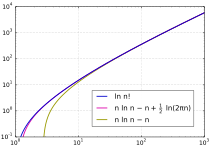
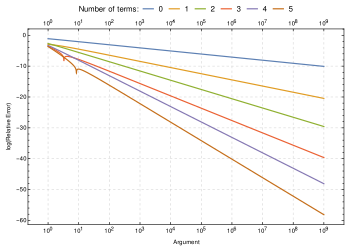
के एक फलन के रूप में, क्रमगुणित घातीय वृद्धि की तुलना में तेज़ है, लेकिन डबल एक्सपोनेंशियल फ़ंक्शन की तुलना में अधिक धीरे-धीरे बढ़ता है।[26] इसकी वृद्धि दर के समान है, लेकिन एक घातांकीय कारक द्वारा धीमी है। इस परिणाम तक पहुँचने का एक तरीका क्रमगुणित का प्राकृतिक लघुगणक लेना है, जो इसके उत्पाद सूत्र को योग में बदल देता है, और फिर एक समाकल द्वारा योग का अनुमान लगाता है:
The binary logarithm of the factorial, used to analyze comparison sorting, can be very accurately estimated using Stirling's approximation. In the formula below, the term invokes big O notation.[30]
विभाज्यता और अंक[संपादित करें]
The product formula for the factorial implies that is divisible by all prime numbers that are at most , and by no larger prime numbers.[31] More precise information about its divisibility is given by Legendre's formula, which gives the exponent of each prime in the prime factorization of as[32][33]
The special case of Legendre's formula for gives the number of trailing zeros in the decimal representation of the factorials.[36] According to this formula, the number of zeros can be obtained by subtracting the base-5 digits of from , and dividing the result by four.[37] Legendre's formula implies that the exponent of the prime is always larger than the exponent for , so each factor of five can be paired with a factor of two to produce one of these trailing zeros.[36] The leading digits of the factorials are distributed according to Benford's law.[38] Every sequence of digits, in any base, is the sequence of initial digits of some factorial number in that base.[39]
Another result on divisibility of factorials, Wilson's theorem, states that is divisible by if and only if is a prime number.[31] For any given integer , the Kempner function of is given by the smallest for which divides .[40] For almost all numbers (all but a subset of exceptions with asymptotic density zero), it coincides with the largest prime factor of .[41]
The product of two factorials, , always evenly divides .[42] There are infinitely many factorials that equal the product of other factorials: if is itself any product of factorials, then equals that same product multiplied by one more factorial, . The only known examples of factorials that are products of other factorials but are not of this "trivial" form are , , and .[43] It would follow from the abc conjecture that there are only finitely many nontrivial examples.[44]
The greatest common divisor of the values of a primitive polynomial of degree over the integers evenly divides .[42]
निरंतर प्रक्षेप और गैर-पूर्णांक सामान्यीकरण[संपादित करें]
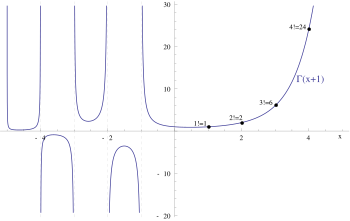
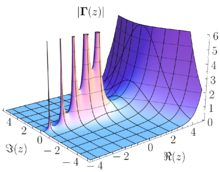
There are infinitely many ways to extend the factorials to a continuous function.[45] The most widely used of these[46] uses the gamma function, which can be defined for positive real numbers as the integral
The same integral converges more generally for any complex number whose real part is positive. It can be extended to the non-integer points in the rest of the complex plane by solving for Euler's reflection formula
Other complex functions that interpolate the factorial values include Hadamard's gamma function, which is an entire function over all the complex numbers, including the non-positive integers.[48][49] In the p-adic numbers, it is not possible to continuously interpolate the factorial function directly, because the factorials of large integers (a dense subset of the p-adics) converge to zero according to Legendre's formula, forcing any continuous function that is close to their values to be zero everywhere. Instead, the p-adic gamma function provides a continuous interpolation of a modified form of the factorial, omitting the factors in the factorial that are divisible by p.[50]
The digamma function is the logarithmic derivative of the gamma function. Just as the gamma function provides a continuous interpolation of the factorials, offset by one, the digamma function provides a continuous interpolation of the harmonic numbers, offset by the Euler–Mascheroni constant.[51]
Computation[संपादित करें]
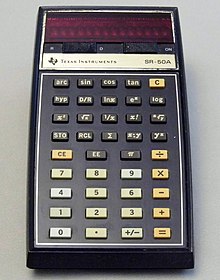
The factorial function is a common feature in scientific calculators.[52] It is also included in scientific programming libraries such as the Python mathematical functions module[53] and the Boost C++ library.[54] If efficiency is not a concern, computing factorials is trivial: just successively multiply a variable initialized to by the integers up to . The simplicity of this computation makes it a common example in the use of different computer programming styles and methods.[55]
The computation of can be expressed in pseudocode using iteration[56] as
define factorial(n):
f := 1
for i := 1, 2, 3, ..., n:
f := f * i
return f
or using recursion[57] based on its recurrence relation as
define factorial(n): if (n = 0) return 1 return n * factorial(n − 1)
Other methods suitable for its computation include memoization,[58] dynamic programming,[59] and functional programming.[60] The computational complexity of these algorithms may be analyzed using the unit-cost random-access machine model of computation, in which each arithmetic operation takes constant time and each number uses a constant amount of storage space. In this model, these methods can compute in time , and the iterative version uses space . Unless optimized for tail recursion, the recursive version takes linear space to store its call stack.[61] However, this model of computation is only suitable when is small enough to allow to fit into a machine word.[62] The values 12! and 20! are the largest factorials that can be stored in, respectively, the 32-bit[63] and 64-bit integers.[64] Floating point can represent larger factorials, but approximately rather than exactly, and will still overflow for factorials larger than .[63]
The exact computation of larger factorials involves arbitrary-precision arithmetic, because of fast growth and integer overflow. Time of computation can be analyzed as a function of the number of digits or bits in the result.[64] By Stirling's formula, has bits.[65] The Schönhage–Strassen algorithm can produce a -bit product in time , and faster multiplication algorithms taking time are known.[66] However, computing the factorial involves repeated products, rather than a single multiplication, so these time bounds do not apply directly. In this setting, computing by multiplying the numbers from 1 to in sequence is inefficient, because it involves multiplications, a constant fraction of which take time each, giving total time . A better approach is to perform the multiplications as a divide-and-conquer algorithm that multiplies a sequence of numbers by splitting it into two subsequences of numbers, multiplies each subsequence, and combines the results with one last multiplication. This approach to the factorial takes total time : one logarithm comes from the number of bits in the factorial, a second comes from the multiplication algorithm, and a third comes from the divide and conquer.[67]
Even better efficiency is obtained by computing n! from its prime factorization, based on the principle that exponentiation by squaring is faster than expanding an exponent into a product.[65][68] An algorithm for this by Arnold Schönhage begins by finding the list of the primes up to , for instance using the sieve of Eratosthenes, and uses Legendre's formula to compute the exponent for each prime. Then it computes the product of the prime powers with these exponents, using a recursive algorithm, as follows:
- Use divide and conquer to compute the product of the primes whose exponents are odd
- Divide all of the exponents by two (rounding down to an integer), recursively compute the product of the prime powers with these smaller exponents, and square the result
- Multiply together the results of the two previous steps
The product of all primes up to is an -bit number, by the prime number theorem, so the time for the first step is , with one logarithm coming from the divide and conquer and another coming from the multiplication algorithm. In the recursive calls to the algorithm, the prime number theorem can again be invoked to prove that the numbers of bits in the corresponding products decrease by a constant factor at each level of recursion, so the total time for these steps at all levels of recursion adds in a geometric series to . The time for the squaring in the second step and the multiplication in the third step are again , because each is a single multiplication of a number with bits. Again, at each level of recursion the numbers involved have a constant fraction as many bits (because otherwise repeatedly squaring them would produce too large a final result) so again the amounts of time for these steps in the recursive calls add in a geometric series to . Consequentially, the whole algorithm takes time , proportional to a single multiplication with the same number of bits in its result.[68]
इन्हें भी देखें[संपादित करें]
सन्दर्भ[संपादित करें]
- ↑ अ आ दत्ता, बिभूतिभूषण; सिंह, अवदेश नारायण (2019). "Use of permutations and combinations in India". प्रकाशित कोलाचना, आदित्य; महेश, के.; रामसुब्रमण्यम, के. (संपा॰). भारतीय गणित और खगोल विज्ञान में अध्ययन: कृपाशंकर शुक्ल के चुनिंदा लेख. Sources and Studies in the History of Mathematics and Physical Sciences. Springer Singapore. पपृ॰ 356–376. S2CID 191141516. डीओआइ:10.1007/978-981-13-7326-8_18.. Revised by K. S. Shukla from a paper in Indian Journal of History of Science 27 (3): 231–249, 1992, साँचा:MR. पृष्ठ 363 देखें
- ↑ जाधव, दीपक (अगस्त 2021). "Jaina Thoughts on Unity Not Being a Number". History of Science in South Asia. University of Alberta Libraries. 9: 209–231. S2CID 238656716. डीओआइ:10.18732/hssa67.. पृष्ठ 211 पर तिथि निर्धारण की चर्चा देखें।
- ↑ Biggs, Norman L. (May 1979). "The roots of combinatorics". Historia Mathematica. 6 (2): 109–136. MR 0530622. डीओआइ:10.1016/0315-0860(79)90074-0.
- ↑ अ आ Katz, Victor J. (जून 1994). "कक्षा में नृजातीय गणित". For the Learning of Mathematics. 14 (2): 26–30. JSTOR 40248112.
- ↑ Sefer Yetzirah at Wikisource, Chapter IV, Section 4
- ↑ Rashed, Roshdi (1980). "Ibn al-Haytham et le théorème de Wilson". Archive for History of Exact Sciences (फ़्रेंच में). 22 (4): 305–321. MR 0595903. S2CID 120885025. डीओआइ:10.1007/BF00717654.
- ↑ Acerbi, F. (2003). "On the shoulders of Hipparchus: a reappraisal of ancient Greek combinatorics". Archive for History of Exact Sciences. 57 (6): 465–502. JSTOR 41134173. MR 2004966. S2CID 122758966. डीओआइ:10.1007/s00407-003-0067-0.
- ↑ Katz, Victor J. (2013). "Chapter 4: Jewish combinatorics". प्रकाशित Wilson, Robin; Watkins, John J. (संपा॰). Combinatorics: Ancient & Modern. Oxford University Press. पपृ॰ 109–121. आई॰ऍस॰बी॰ऍन॰ 978-0-19-965659-2. पृष्ठ 111 देखें।
- ↑ Hunt, Katherine (May 2018). "परिवर्तन की कला: सत्रहवीं सदी के इंग्लैंड में घंटी बजाना, अनाग्राम और संयोजन की संस्कृति" (PDF). Journal of Medieval and Early Modern Studies. 48 (2): 387–412. डीओआइ:10.1215/10829636-4403136.
- ↑ Stedman, Fabian (1677). Campanalogia. London. पपृ॰ 6–9. The publisher is given as "W.S." who may have been William Smith, possibly acting as agent for the Society of College Youths, to which society the "Dedicatory" is addressed.
- ↑ Knobloch, Eberhard (2013). "Chapter 5: Renaissance combinatorics". प्रकाशित Wilson, Robin; Watkins, John J. (संपा॰). Combinatorics: Ancient & Modern. Oxford University Press. पपृ॰ 123–145. आई॰ऍस॰बी॰ऍन॰ 978-0-19-965659-2. पृष्ठ 126 देखें।
- ↑ Knobloch 2013, पृ॰प॰ 130–133.
- ↑ अ आ Ebbinghaus, H.-D.; Hermes, H.; Hirzebruch, F.; Koecher, M.; Mainzer, K.; Neukirch, J.; Prestel, A.; Remmert, R. (1990). Numbers. Graduate Texts in Mathematics. 123. New York: Springer-Verlag. पृ॰ 131. MR 1066206. आई॰ऍस॰बी॰ऍन॰ 0-387-97202-1. डीओआइ:10.1007/978-1-4612-1005-4.
- ↑ Dutka, Jacques (1991). "क्रमगुणित फलन का प्रारंभिक इतिहास". Archive for History of Exact Sciences. 43 (3): 225–249. JSTOR 41133918. MR 1171521. S2CID 122237769. डीओआइ:10.1007/BF00389433.
- ↑ Dickson, Leonard E. (1919). "Chapter IX: Divisibility of factorials and multinomial coefficients". History of the Theory of Numbers. 1. Carnegie Institution of Washington. पपृ॰ 263–278. See in particular p. 263.
- ↑ अ आ Cajori, Florian (1929). "448–449. Factorial "n"". A History of Mathematical Notations, Volume II: Notations Mainly in Higher Mathematics. The Open Court Publishing Company. पपृ॰ 71–77.
- ↑ Miller, Jeff. "Earliest Known Uses of Some of the Words of Mathematics (F)". MacTutor History of Mathematics archive. University of St Andrews.
- ↑ Craik, Alex D. D. (2005). "Prehistory of Faà di Bruno's formula". The American Mathematical Monthly. 112 (2): 119–130. JSTOR 30037410. MR 2121322. S2CID 45380805. डीओआइ:10.1080/00029890.2005.11920176.
- ↑ Arbogast, Louis François Antoine (1800). Du calcul des dérivations (फ़्रेंच में). Strasbourg: L'imprimerie de Levrault, frères. पपृ॰ 364–365.
- ↑ अ आ सन्दर्भ त्रुटि:
<ref>का गलत प्रयोग;gkpनाम के संदर्भ में जानकारी नहीं है। - ↑ अ आ हैमकिंस, जोएल डेविड (2020). प्रमाण और गणित की कला. कैम्ब्रिज, मैसाचुसेट्स: एमआईटी प्रेस. पृ॰ 50. MR 4205951. आई॰ऍस॰बी॰ऍन॰ 978-0-262-53979-1.
- ↑ Dorf, Richard C. (2003). "Factorials". CRC Handbook of Engineering Tables. CRC Press. पृ॰ 5-5. आई॰ऍस॰बी॰ऍन॰ 978-0-203-00922-2.
- ↑ गोल्डनबर्ग, ई. पॉल; कार्टर, सिंथिया जे. (अक्टूबर 2017). "एक छात्र (−5) के बारे में पूछता है!". The Mathematics Teacher. 111 (2): 104–110. JSTOR 10.5951/mathteacher.111.2.0104. डीओआइ:10.5951/mathteacher.111.2.0104.
- ↑ Haberman, Bruria; Averbuch, Haim (2002). "कंप्यूटर विज्ञान शिक्षा में नवाचार और प्रौद्योगिकी पर 7वें वार्षिक SIGCSE सम्मेलन की कार्यवाही, ITiCSE 2002, आरहूस, डेनमार्क, 24-28 जून, 2002". In Caspersen, Michael E.; Joyce, Daniel T.; Goelman, Don et al.. एसोसिएशन फॉर कंप्यूटिंग मशीनरी. p. 84–88. doi:10.1145/544414.544441.
- ↑ फैरेल, ओरिन जे.; रॉस, बर्ट्रम (1971). विश्लेषण में हल की गई समस्याएं: जैसा कि गामा, बीटा, लीजेंड्रे और बेसेल फ़ंक्शन पर लागू होता है. डोवर बुक्स ऑन मैथमेटिक्स. कूरियर कॉर्पोरेशन. पृ॰ 10. आई॰ऍस॰बी॰ऍन॰ 978-0-486-78308-6.
- ↑ Cameron, Peter J. (1994). "2.4: Orders of magnitude". Combinatorics: Topics, Techniques, Algorithms. Cambridge University Press. पपृ॰ 12–14. आई॰ऍस॰बी॰ऍन॰ 978-0-521-45133-8.
- ↑ Magnus, Robert (2020). "11.10: Stirling's approximation". Fundamental Mathematical Analysis. Springer Undergraduate Mathematics Series. Cham: Springer. पृ॰ 391. MR 4178171. S2CID 226465639. आई॰ऍस॰बी॰ऍन॰ 978-3-030-46321-2. डीओआइ:10.1007/978-3-030-46321-2.
- ↑ Palmer, Edgar M. (1985). "Appendix II: Stirling's formula". Graphical Evolution: An introduction to the theory of random graphs. Wiley-Interscience Series in Discrete Mathematics. Chichester: John Wiley & Sons. पपृ॰ 127–128. MR 0795795. आई॰ऍस॰बी॰ऍन॰ 0-471-81577-2.
- ↑ अ आ इ Chen, Chao-Ping; Lin, Long (2012). "Remarks on asymptotic expansions for the gamma function". Applied Mathematics Letters. 25 (12): 2322–2326. MR 2967837. डीओआइ:10.1016/j.aml.2012.06.025.
- ↑ Knuth, Donald E. (1998). The Art of Computer Programming, Volume 3: Sorting and Searching (2nd संस्करण). Addison-Wesley. पृ॰ 182. आई॰ऍस॰बी॰ऍन॰ 978-0-321-63578-5.
- ↑ अ आ Beiler, Albert H. (1966). Recreations in the Theory of Numbers: The Queen of Mathematics Entertains. Dover Recreational Math Series (2nd संस्करण). Courier Corporation. पृ॰ 49. आई॰ऍस॰बी॰ऍन॰ 978-0-486-21096-4.
- ↑ Chvátal 2021. "1.4: Legendre's formula". pp. 6–7.
- ↑ अ आ Robert, Alain M. (2000). "3.1: The -adic valuation of a factorial". A Course in -adic Analysis. Graduate Texts in Mathematics. 198. New York: Springer-Verlag. पपृ॰ 241–242. MR 1760253. आई॰ऍस॰बी॰ऍन॰ 0-387-98669-3. डीओआइ:10.1007/978-1-4757-3254-2.
- ↑ Peitgen, Heinz-Otto; Jürgens, Hartmut; Saupe, Dietmar (2004). "Kummer's result and Legendre's identity". Chaos and Fractals: New Frontiers of Science. New York: Springer. पपृ॰ 399–400. आई॰ऍस॰बी॰ऍन॰ 978-1-4684-9396-2. डीओआइ:10.1007/b97624.
- ↑ Alladi, Krishnaswami; Grinstead, Charles (1977). "On the decomposition of n! into prime powers". Journal of Number Theory (अंग्रेज़ी में). 9 (4): 452–458. डीओआइ:10.1016/0022-314x(77)90006-3.
- ↑ अ आ Koshy, Thomas (2007). "Example 3.12". Elementary Number Theory with Applications (2nd संस्करण). Elsevier. पृ॰ 178. आई॰ऍस॰बी॰ऍन॰ 978-0-08-054709-1.
- ↑ साँचा:Cite OEIS
- ↑ Diaconis, Persi (1977). "The distribution of leading digits and uniform distribution mod 1". Annals of Probability. 5 (1): 72–81. MR 0422186. डीओआइ:10.1214/aop/1176995891.
- ↑ Bird, R. S. (1972). "Integers with given initial digits". The American Mathematical Monthly. 79 (4): 367–370. JSTOR 2978087. MR 0302553. डीओआइ:10.1080/00029890.1972.11993051.
- ↑ Kempner, A. J. (1918). "Miscellanea". The American Mathematical Monthly. 25 (5): 201–210. JSTOR 2972639. डीओआइ:10.2307/2972639.
- ↑ Erdős, Paul; Kastanas, Ilias (1994). "The smallest factorial that is a multiple of n (solution to problem 6674)" (PDF). The American Mathematical Monthly. 101: 179. JSTOR 2324376. डीओआइ:10.2307/2324376..
- ↑ अ आ Bhargava, Manjul (2000). "The factorial function and generalizations". The American Mathematical Monthly. 107 (9): 783–799. CiteSeerX 10.1.1.585.2265. JSTOR 2695734. डीओआइ:10.2307/2695734.
- ↑ Guy 2004. "B23: Equal products of factorials". p. 123.
- ↑ Luca, Florian (2007). "On factorials which are products of factorials". Mathematical Proceedings of the Cambridge Philosophical Society. 143 (3): 533–542. MR 2373957. S2CID 120875316. डीओआइ:10.1017/S0305004107000308. बिबकोड:2007MPCPS.143..533L.
- ↑ अ आ Davis, Philip J. (1959). "Leonhard Euler's integral: A historical profile of the gamma function". The American Mathematical Monthly. 66 (10): 849–869. JSTOR 2309786. MR 0106810. डीओआइ:10.1080/00029890.1959.11989422.
- ↑ अ आ Borwein, Jonathan M.; Corless, Robert M. (2018). "Gamma and factorial in the Monthly". The American Mathematical Monthly. 125 (5): 400–424. arXiv:1703.05349. MR 3785875. S2CID 119324101. डीओआइ:10.1080/00029890.2018.1420983.
- ↑ Remmert, Reinhold (1996). "Wielandt's theorem about the -function". The American Mathematical Monthly. 103 (3): 214–220. JSTOR 2975370. MR 1376175. डीओआइ:10.1080/00029890.1996.12004726.
- ↑ Hadamard, J. (1968). "Sur l'expression du produit 1·2·3· · · · ·(n−1) par une fonction entière" (PDF). Œuvres de Jacques Hadamard (फ़्रेंच में). Paris: Centre National de la Recherche Scientifiques. नामालूम प्राचल
|orig-date=की उपेक्षा की गयी (मदद) - ↑ Alzer, Horst (2009). "A superadditive property of Hadamard's gamma function". Abhandlungen aus dem Mathematischen Seminar der Universität Hamburg. 79 (1): 11–23. MR 2541340. S2CID 123691692. डीओआइ:10.1007/s12188-008-0009-5.
- ↑ Robert 2000. "7.1: The gamma function ". pp. 366–385.
- ↑ Ross, Bertram (1978). "The psi function". Mathematics Magazine. 51 (3): 176–179. JSTOR 2689999. MR 1572267. डीओआइ:10.1080/0025570X.1978.11976704.
- ↑ Brase, Charles Henry; Brase, Corrinne Pellillo (2014). Understandable Statistics: Concepts and Methods (11th संस्करण). Cengage Learning. पृ॰ 182. आई॰ऍस॰बी॰ऍन॰ 978-1-305-14290-9.
- ↑ "math — Mathematical functions". Python 3 Documentation: The Python Standard Library. अभिगमन तिथि 2021-12-21.
- ↑ "Factorial". Boost 1.78.0 Documentation: Math Special Functions. अभिगमन तिथि 2021-12-21.
- ↑ Addis, Tom; Addis, Jan (2009). Drawing Programs: The Theory and Practice of Schematic Functional Programming. Springer. पपृ॰ 149–150. आई॰ऍस॰बी॰ऍन॰ 978-1-84882-618-2.
- ↑ Chapman, Stephen J. (2019). "Example 5.2: The factorial function". MATLAB Programming for Engineers (6th संस्करण). Cengage Learning. पृ॰ 215. आई॰ऍस॰बी॰ऍन॰ 978-0-357-03052-3.
- ↑ Hey, Tony; Pápay, Gyuri (2014). The Computing Universe: A Journey through a Revolution. Cambridge University Press. पृ॰ 64. आई॰ऍस॰बी॰ऍन॰ 9781316123225.
- ↑ Bolboaca, Alexandru (2019). Hands-On Functional Programming with C++: An effective guide to writing accelerated functional code using C++17 and C++20. Packt Publishing. पृ॰ 188. आई॰ऍस॰बी॰ऍन॰ 978-1-78980-921-3.
- ↑ Gray, John W. (2014). Mastering Mathematica: Programming Methods and Applications. Academic Press. पपृ॰ 233–234. आई॰ऍस॰बी॰ऍन॰ 978-1-4832-1403-0.
- ↑ Torra, Vicenç (2016). Scala From a Functional Programming Perspective: An Introduction to the Programming Language. Lecture Notes in Computer Science. 9980. Springer. पृ॰ 96. आई॰ऍस॰बी॰ऍन॰ 978-3-319-46481-7.
- ↑ Sussman, Gerald Jay (1982). "LISP, programming, and implementation". Functional Programming and Its Applications: An Advanced Course. CREST Advanced Courses. Cambridge University Press. पपृ॰ 29–72. आई॰ऍस॰बी॰ऍन॰ 978-0-521-24503-6. See in particular p. 34.
- ↑ Chaudhuri, Ranjan (June 2003). "Do the arithmetic operations really execute in constant time?". ACM SIGCSE Bulletin. Association for Computing Machinery. 35 (2): 43–44. S2CID 13629142. डीओआइ:10.1145/782941.782977.
- ↑ अ आ Fateman, Richard J. (April 11, 2006). "Comments on Factorial Programs" (PDF). University of California, Berkeley.
- ↑ अ आ Winkler, Jürgen F. H.; Kauer, Stefan (March 1997). "Proving assertions is also useful". ACM SIGPLAN Notices. Association for Computing Machinery. 32 (3): 38–41. S2CID 17347501. डीओआइ:10.1145/251634.251638.
- ↑ अ आ Borwein, Peter B. (1985). "On the complexity of calculating factorials". Journal of Algorithms. 6 (3): 376–380. MR 0800727. डीओआइ:10.1016/0196-6774(85)90006-9.
- ↑ Harvey, David; van der Hoeven, Joris (2021). "Integer multiplication in time " (PDF). Annals of Mathematics. Second Series. 193 (2): 563–617. MR 4224716. S2CID 109934776. डीओआइ:10.4007/annals.2021.193.2.4.
- ↑ Arndt, Jörg (2011). "34.1.1.1: Computation of the factorial". Matters Computational: Ideas, Algorithms, Source Code (PDF). Springer. पपृ॰ 651–652. See also "34.1.5: Performance", pp. 655–656.
- ↑ अ आ Schönhage, Arnold (1994). Fast algorithms: a multitape Turing machine implementation. B.I. Wissenschaftsverlag. पृ॰ 226.
बाहरी कड़ियाँ[संपादित करें]
- क्रमगुणित कैलकुलेटर और एल्गोरिदम
- क्रमगुणित कैलकुलेटर: तुरन्त 10^14! तक के क्रमगुणित ढूंढता है
- एनिमेटेड क्रमगुणित कैलकुलेटर: सामान्य प्राथमिक विद्यालय के एग्लॉरिथम का उपयोग करके हाथ से गणना किए गए क्रमगुणित को दर्शाता है
- "क्रमगुणित" एड पेग, जूनियर और रॉब मॉरिस द्वारा, वोल्फ्राम डेमोंस्ट्रेशन प्रोजेक्ट, 2007.
- तेज़ क्रमगुणित फलन (जावा, सी#, सी++, स्काला और गो में स्रोत कोड के साथ)


































































